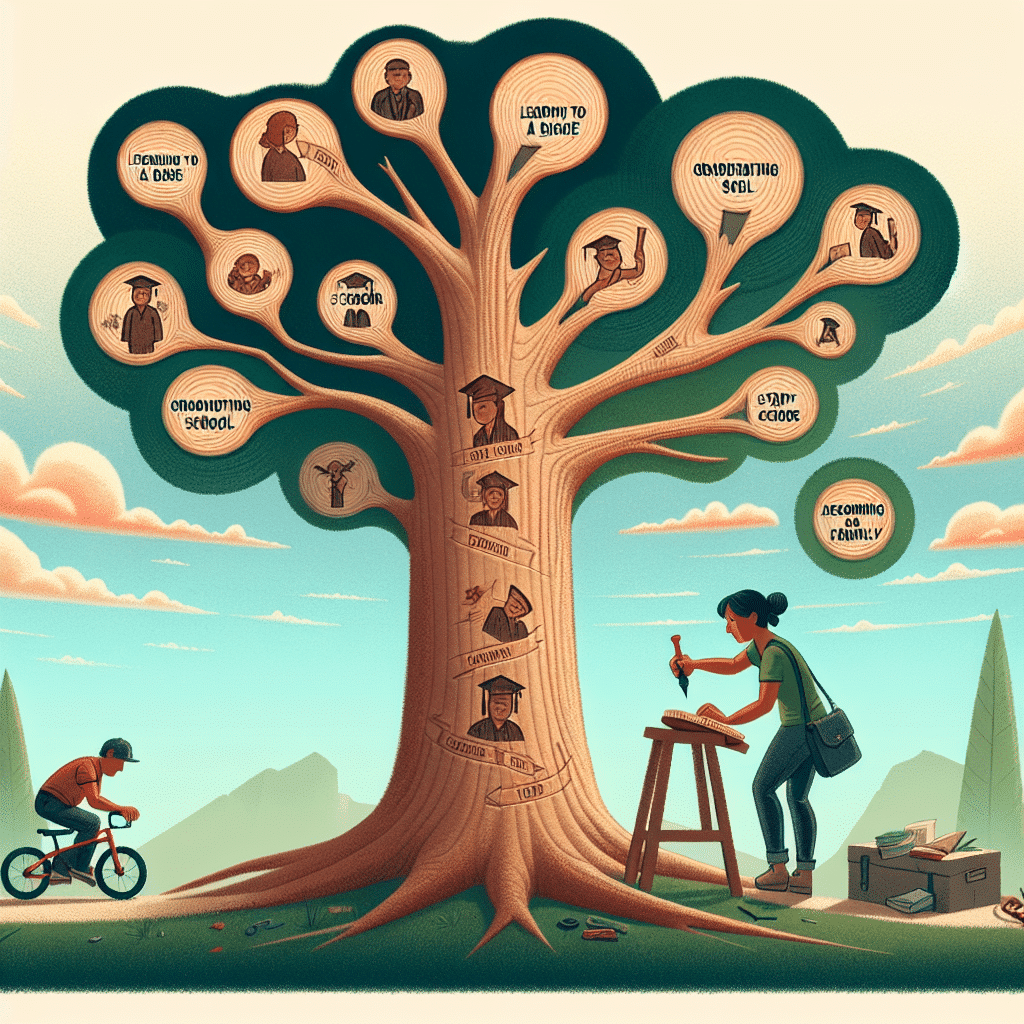
Personal growth is a transformative process that is unique to every individual. In this article, we will explore the power of narrative construction in personal growth and how crafting your personal growth story can contribute to your overall development. By sharing your journey of overcoming challenges and embracing transformation, you can inspire and motivate others along their own paths of growth.
Crafting Your Personal Growth Story
When it comes to personal growth, one of the most crucial aspects is crafting your own narrative. Your personal growth story is a powerful tool that can help you make sense of your experiences, understand your progress, and inspire others along the way.
So how can you craft your personal growth story? Here are some steps to help you get started:
1. Reflect on Your Journey
Begin by reflecting on your personal growth journey so far. Take time to consider the experiences, challenges, and accomplishments that have shaped you. Think about the turning points, moments of self-discovery, and important lessons you have learned along the way.
By reflecting on your journey, you gain a deeper understanding of how far you have come and the growth you have experienced. This reflection forms the foundation of your personal growth story.
2. Identify Key Themes and Patterns
Next, identify the key themes and patterns that emerge from your reflections. Look for common threads in your experiences and the lessons you have learned. These themes and patterns are the building blocks of your personal growth story.
For example, you may identify that resilience is a recurring theme in your journey – the ability to bounce back from setbacks and use them as stepping stones towards growth. Or, you may find that vulnerability and self-acceptance have been central to your personal growth.
3. Find the Narrative Arc
Once you have identified the key themes and patterns, it’s time to find the narrative arc of your personal growth story. This arc consists of the beginning, middle, and end – the journey you have taken, the challenges you have faced, and the growth you have achieved.
Think about how your story begins – the catalyst that sparked your journey of personal growth. Consider the obstacles and challenges you encountered along the way and how you overcame them. Finally, reflect on the transformation and growth you have experienced, and how your perspective and mindset have evolved.
4. Emphasize Key Learnings and Takeaways
An essential part of crafting your personal growth story is emphasizing the key learnings and takeaways. These are the lessons that you want to share with others and inspire them to embark on their own journeys of personal growth.
Consider the insights you have gained and the wisdom you have acquired through your experiences. How can these lessons help others who may be facing similar challenges or seeking personal growth?
By emphasizing the key learnings and takeaways in your personal growth story, you create a narrative that not only reflects your own journey but also offers guidance and inspiration to others.
Crafting your personal growth story is not only a powerful tool for reflection and self-understanding, but it also allows you to inspire and connect with others on a deeper level. By sharing your story, you become a beacon of hope and motivation for those seeking personal growth themselves.
Overcoming Challenges and Obstacles
Embarking on a personal growth journey inherently involves challenges and obstacles along the way. These obstacles can come in various forms, whether they are internal, external, or a combination of both. However, it is important to remember that these challenges are an essential part of the narrative construction in personal growth.
One of the first steps in overcoming challenges is to identify and acknowledge them. This requires self-reflection and a deep understanding of oneself. By recognizing the challenges that stand in your way, you can begin to develop strategies and solutions to overcome them.
Internal obstacles often manifest as limiting beliefs and negative thought patterns that can hold you back from reaching your full potential. These may include fear of failure, self-doubt, or a lack of confidence. Be aware of these internal barriers and work on reframing your mindset to one that is more positive and growth-oriented.
External obstacles, on the other hand, may involve circumstances and situations that present roadblocks to personal growth. These may be related to work, relationships, or other aspects of your life. It is important to approach these external challenges with a problem-solving mindset, seeking support or resources as needed to navigate through them.
During the process of overcoming challenges, it is crucial to maintain a sense of resilience and perseverance. Personal growth is not a linear path, and setbacks are bound to occur. However, viewing these setbacks as opportunities for learning and growth can help you stay motivated and continue moving forward on your journey.
In addition to resilience, cultivating self-compassion is also key. Recognize that personal growth is a process, and it is okay to stumble along the way. Treat yourself with kindness and understanding, and use setbacks as fuel for personal development and improvement.
Ultimately, overcoming challenges and obstacles is an integral part of the narrative construction in personal growth. Your journey will be unique and filled with both triumphs and hardships. Embrace the challenges as opportunities for growth and transformation, and remember that with determination and perseverance, you have the power to overcome anything that stands in your way.

Embracing Transformation and Growth
Embracing transformation and growth is a crucial aspect of personal development. It involves leaving behind old patterns and beliefs that no longer serve us and embracing new ways of thinking and being. This process can be both exciting and challenging, but ultimately leads to profound personal growth and fulfillment.
Understanding the Need for Change
Before we can embrace transformation and growth, we must first recognize the need for change. This requires a deep and honest reflection on our current circumstances and an assessment of whether they align with our values and goals. Sometimes, this realization can come from hitting rock bottom or experiencing a major life event that forces us to reevaluate our choices.
Once we acknowledge the need for change, we can begin the process of transformation.
Reframing Limiting Beliefs
During the journey of personal growth, we often encounter limiting beliefs that hold us back from reaching our full potential. These beliefs are formed over time, influenced by our upbringing, experiences, and societal conditioning. They can manifest as self-doubt, fear of failure, or a lack of confidence.
Embracing transformation requires us to reframe these limiting beliefs and replace them with empowering ones. This might involve challenging our negative self-talk, seeking support from mentors, or implementing daily affirmations to reprogram our subconscious mind.
Cultivating Resilience
As we embark on our personal growth journey, we are likely to face various challenges and obstacles. These can come in the form of setbacks, failures, or unexpected circumstances. Embracing transformation means cultivating resilience and developing the ability to bounce back from adversity.
Resilience is not about avoiding or suppressing difficult emotions; it’s about acknowledging them, learning from them, and using them to fuel our growth. It involves developing problem-solving skills, embracing a growth mindset, and maintaining a positive attitude even in the face of challenges.
Forging a New Path
Embracing transformation means charting a new course for our lives. This might involve setting clear goals, creating a vision for the future, and taking intentional actions towards our desired outcomes. It requires stepping out of our comfort zones, taking risks, and embracing the unknown.
Moreover, embracing transformation also involves letting go of attachments to past identities and embracing the process of becoming who we truly want to be. This can be a deeply transformative and liberating experience.
Embracing Growth as a Lifelong Journey
Finally, it’s important to remember that personal growth is a lifelong journey. Embracing transformation is not a one-time event but an ongoing process. The key is to stay committed to our growth, remain open to learning and evolving, and continue seeking new opportunities for personal development.
By embracing transformation and growth, we unlock our full potential and create a life that aligns with our authentic selves. It is a journey that requires courage, self-reflection, and an unwavering commitment to personal development.
Sharing Your Personal Growth Journey with Others
One of the most powerful aspects of personal growth narratives is the ability to inspire and motivate others on their own journeys. Sharing your personal growth story can provide valuable insights and encouragement to those who may be facing similar challenges or seeking guidance.
When sharing your personal growth journey, it’s important to keep the following points in mind:
Authenticity
Be authentic and genuine when sharing your story. People resonate with honesty, vulnerability, and relatability. By sharing both your successes and failures, you can show others that personal growth is a continuous process and that setbacks are a natural part of the journey.
Clarity and Structure
Organize your narrative in a clear and structured manner. Start with an introduction that highlights the key turning point or moment that initiated your personal growth journey. Then, delve into the challenges, obstacles, and lessons you encountered along the way. Conclude by reflecting on the transformation and growth you have experienced.
Empathy and Empowerment
As you share your personal growth story, remember to convey empathy and compassion towards your audience. Acknowledge their struggles and challenges, and provide practical advice or actionable steps they can take to facilitate their own personal growth. Use your story as a tool to empower others and inspire them to embark on their own transformative journeys.
Utilize Different Mediums
Consider various mediums to share your personal growth narrative. Whether it’s through writing a blog or an article, recording a podcast, creating videos, or speaking at events, choosing the right medium can enhance the impact of your story. Different mediums resonate with different audiences, so explore options that align with your strengths and preferences.
Engage with your Audience
Engagement is key when sharing your personal growth journey. Encourage your audience to interact with your story by asking questions, providing opportunities for discussion, or inviting them to share their experiences. Actively respond to comments and messages, fostering a sense of community and connection.
By sharing your personal growth journey, you can inspire, motivate, and support others in their own paths of self-discovery. Your story has the potential to create a ripple effect, sparking positive change and transformation in the lives of those who listen. Embrace the power of narrative construction in personal growth and become a catalyst for others to embrace their true potential.

Summary
The power of personal growth narratives lies in their ability to inspire transformation and foster self-reflection. Crafting your personal growth story involves understanding your journey, identifying challenges, and embracing your growth. Overcoming obstacles is an essential part of personal growth, as it allows for learning and resilience. Embracing transformation and growth involves self-acceptance, openness to change, and a growth mindset. Sharing your personal growth journey with others can inspire and support their own growth, creating a ripple effect of positive change. Overall, narrative construction plays a crucial role in personal growth by giving meaning and purpose to our experiences, fostering introspection, and enabling transformation.






